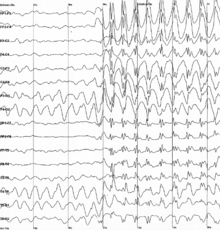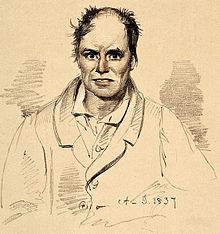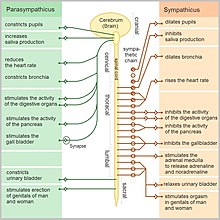User:Nolan Perry/sandbox portal
Portal maintenance status: (May 2019)
|
Introduction
Autism spectrum disorder (ASD), or simply autism, is a neurodevelopmental disorder "characterized by persistent deficits in social communication and social interaction across multiple contexts" and "restricted, repetitive patterns of behavior, interests, or activities". Sensory abnormalities are also included in the diagnostic manuals. Common associated traits such as motor coordination impairment are typical of the condition but not required for diagnosis. A formal diagnosis requires that symptoms cause significant impairment in multiple functional domains; in addition, the symptoms must be atypical or excessive for the person's age and sociocultural context.
Autism is a spectrum, meaning it manifests in various ways, with its severity and support needs varying widely across different autistic people. For example, some autistic people are nonverbal, while others have proficient spoken language. Furthermore, the spectrum is multi-dimensional and not all dimensions have been identified as of 2024[update]. (Full article...)
Selected general articles
-
Image 1Attention deficit hyperactivity disorder (ADHD) is a neurodevelopmental disorder characterized by symptoms of inattention, hyperactivity, impulsivity and emotional dysregulation that are excessive and pervasive, impairing in multiple contexts, and developmentally-inappropriate. ADHD symptoms arise from executive dysfunction.
Impairments resulting from deficits in self-regulation such as time management, inhibition, task initiation, and sustained attention can include poor professional performance, relationship difficulties, and numerous health risks, collectively predisposing to a diminished quality of life and a reduction in life expectancy. It is associated with other mental disorders as well as non-psychiatric disorders, which can cause additional impairment. The disorder costs society hundreds of billions of US dollars each year, worldwide. (Full article...) -
Image 2
Epilepsy is a group of non-communicable neurological disorders characterized by recurrent epileptic seizures. An epileptic seizure is the clinical manifestation of an abnormal, excessive, and synchronized electrical discharge in the neurons. The occurrence of two or more unprovoked seizures defines epilepsy. The occurrence of just one seizure may warrant the definition (set out by the International League Against Epilepsy) in a more clinical usage where recurrence may be able to be prejudged. Epileptic seizures can vary from brief and nearly undetectable periods to long periods of vigorous shaking due to abnormal electrical activity in the brain. These episodes can result in physical injuries, either directly, such as broken bones, or through causing accidents. In epilepsy, seizures tend to recur and may have no detectable underlying cause. Isolated seizures that are provoked by a specific cause such as poisoning are not deemed to represent epilepsy. People with epilepsy may be treated differently in various areas of the world and experience varying degrees of social stigma due to the alarming nature of their symptoms.
The underlying mechanism of an epileptic seizure is excessive and abnormal neuronal activity in the cortex of the brain, which can be observed in the electroencephalogram (EEG) of an individual. The reason this occurs in most cases of epilepsy is unknown (cryptogenic); some cases occur as the result of brain injury, stroke, brain tumors, infections of the brain, or birth defects through a process known as epileptogenesis. Known genetic mutations are directly linked to a small proportion of cases. The diagnosis involves ruling out other conditions that might cause similar symptoms, such as fainting, and determining if another cause of seizures is present, such as alcohol withdrawal or electrolyte problems. This may be partly done by imaging the brain and performing blood tests. Epilepsy can often be confirmed with an EEG, but a normal reading does not rule out the condition. (Full article...) -
Image 3Schematic of basal ganglia overlain on the cerebral cortex
The basal ganglia (BG) or basal nuclei are a group of subcortical nuclei found in the brains of vertebrates. In humans and other primates, differences exist, primarily in the division of the globus pallidus into external and internal regions, and in the division of the striatum. Positioned at the base of the forebrain and the top of the midbrain, they have strong connections with the cerebral cortex, thalamus, brainstem and other brain areas. The basal ganglia are associated with a variety of functions, including regulating voluntary motor movements, procedural learning, habit formation, conditional learning, eye movements, cognition, and emotion.
The main functional components of the basal ganglia include the striatum, consisting of both the dorsal striatum (caudate nucleus and putamen) and the ventral striatum (nucleus accumbens and olfactory tubercle), the globus pallidus, the ventral pallidum, the substantia nigra, and the subthalamic nucleus. Each of these components has complex internal anatomical and neurochemical structures. The largest component, the striatum (dorsal and ventral), receives input from various brain areas but only sends output to other components of the basal ganglia. The globus pallidus receives input from the striatum and sends inhibitory output to a number of motor-related areas. The substantia nigra is the source of the striatal input of the neurotransmitter dopamine, which plays an important role in basal ganglia function. The subthalamic nucleus mainly receives input from the striatum and cerebral cortex and projects to the globus pallidus. (Full article...) -
Image 4

Autistic art depicting a special interest in cats
Special interests are highly focused interests common in autistic people; they are more intense than typical interests, such as hobbies, and may take up much of a person's free time. A person with a special interest will often hyperfocus on their special interest for hours, want to learn as much as possible on the topic, collect related items, and incorporate their special interest into play and art.
Some interests are more likely to be seen as special interests if they are particularly unusual, specific, or niche. Autism rights advocates and psychologists say this binary of acceptable "passions" and pathologised "obsessions" is unfair. Terms like circumscribed interests, obsessions, or restricted interests have historically been used to describe special interests, but these terms are discouraged by autism rights advocates.
Special interests are sometimes confused with hyperfixations. Hyperfixations are short-lived periods of strong interest in a subject over a few days to months which can occur in anyone (although are especially common in people with ADHD), while special interests are an autistic trait and usually last years. (Full article...) -
Image 5Children with intellectual disabilities and other developmental conditions competing in the Special Olympics World Games
Intellectual disability (ID), also known as general learning disability (in the United Kingdom), and formerly mental retardation (in the United States), is a generalized neurodevelopmental disorder characterized by significant impairment in intellectual and adaptive functioning that is first apparent during childhood. Children with intellectual disabilities typically have an intelligence quotient (IQ) below 70 and deficits in at least two adaptive behaviors that affect everyday living. According to the DSM-5, intellectual functions include reasoning, problem solving, planning, abstract thinking, judgment, academic learning, and learning from experience. Deficits in these functions must be confirmed by clinical evaluation and individualized standard IQ testing. On the other hand, adaptive behaviors include the social, developmental, and practical skills people learn to perform tasks in their everyday lives. Deficits in adaptive functioning often compromise an individual's independence and ability to meet their social responsibility.
Intellectual disability is subdivided into syndromic intellectual disability, in which intellectual deficits associated with other medical and behavioral signs and symptoms are present, and non-syndromic intellectual disability, in which intellectual deficits appear without other abnormalities. Down syndrome and fragile X syndrome are examples of syndromic intellectual disabilities. (Full article...) -
Image 6People at a Learning Disabilities Month event in Times Square in 2012
Learning disability, learning disorder, or learning difficulty (British English) is a condition in the brain that causes difficulties comprehending or processing information and can be caused by several different factors. Given the "difficulty learning in a typical manner", this does not exclude the ability to learn in a different manner. Therefore, some people can be more accurately described as having a "learning difference", thus avoiding any misconception of being disabled with a possible lack of an ability to learn and possible negative stereotyping. In the United Kingdom, the term "learning disability" generally refers to an intellectual disability, while conditions such as dyslexia and dyspraxia are usually referred to as "learning difficulties".
While learning disability and learning disorder are often used interchangeably, they differ in many ways. Disorder refers to significant learning problems in an academic area. These problems, however, are not enough to warrant an official diagnosis. Learning disability, on the other hand, is an official clinical diagnosis, whereby the individual meets certain criteria, as determined by a professional (such as a psychologist, psychiatrist, speech-language pathologist, or paediatrician). The difference is in the degree, frequency, and intensity of reported symptoms and problems, and thus the two should not be confused. When the term "learning disorder" is used, it describes a group of disorders characterized by inadequate development of specific academic, language, and speech skills. Types of learning disorders include reading (dyslexia), arithmetic (dyscalculia) and writing (dysgraphia). (Full article...) -
Image 7In physiology, nociception (/ˌnəʊsɪˈsɛpʃ(ə)n/), also nocioception; from Latin nocere 'to harm/hurt') is the sensory nervous system's process of encoding noxious stimuli. It deals with a series of events and processes required for an organism to receive a painful stimulus, convert it to a molecular signal, and recognize and characterize the signal to trigger an appropriate defensive response.
In nociception, intense chemical (e.g., capsaicin present in chili pepper or cayenne pepper), mechanical (e.g., cutting, crushing), or thermal (heat and cold) stimulation of sensory neurons called nociceptors produces a signal that travels along a chain of nerve fibers via the spinal cord to the brain. Nociception triggers a variety of physiological and behavioral responses to protect the organism against an aggression, and usually results in a subjective experience, or perception, of pain in sentient beings. (Full article...) -
Image 8

The Cognitive Bias Codex
A cognitive bias is a systematic pattern of deviation from norm or rationality in judgment. Individuals create their own "subjective reality" from their perception of the input. An individual's construction of reality, not the objective input, may dictate their behavior in the world. Thus, cognitive biases may sometimes lead to perceptual distortion, inaccurate judgment, illogical interpretation, and irrationality.
While cognitive biases may initially appear to be negative, some are adaptive. They may lead to more effective actions in a given context. Furthermore, allowing cognitive biases enables faster decisions which can be desirable when timeliness is more valuable than accuracy, as illustrated in heuristics. Other cognitive biases are a "by-product" of human processing limitations, resulting from a lack of appropriate mental mechanisms (bounded rationality), the impact of an individual's constitution and biological state (see embodied cognition), or simply from a limited capacity for information processing. Research suggests that cognitive biases can make individuals more inclined to endorsing pseudoscientific beliefs by requiring less evidence for claims that confirm their preconceptions. This can potentially distort their perceptions and lead to inaccurate judgments. (Full article...) -
Image 9Babbling is a stage in child development and a state in language acquisition during which an infant appears to be experimenting with uttering articulate sounds, but does not yet produce any recognizable words. Babbling begins shortly after birth and progresses through several stages as the infant's repertoire of sounds expands and vocalizations become more speech-like. Infants typically begin to produce recognizable words when they are around 12 months of age, though babbling may continue for some time afterward.
Babbling can be seen as a precursor to language development or simply as vocal experimentation. The physical structures involved in babbling are still being developed in the first year of a child's life. This continued physical development is responsible for some of the changes in abilities and variations of sound babies can produce. Abnormal developments such as certain medical conditions, developmental delays, and hearing impairments may interfere with a child's ability to babble normally. Though there is still disagreement about the uniqueness of language to humans, babbling is not unique to the human species. (Full article...) -
Image 10Pathological demand avoidance (PDA), or extreme demand avoidance (EDA), is a proposed mental disorder characterized by greater-than-typical refusal to comply with requests or expectations—demand avoidance—and extreme efforts to avoid social demands. Any expectation, even routine activities, such as brushing teeth, or highly desired activities, such as getting ready to leave home to visit a playground, can trigger avoidant behavior. If the demand cannot be avoided, a panic attack or a meltdown may ensue. (Full article...)
-
Image 11Lithograph of a person diagnosed with melancholia and strong suicidal tendency in 1892
Depression is a mental state of low mood and aversion to activity. It affects about 3.5% of the global population, or about 280 million people worldwide, as of 2020. Depression affects a person's thoughts, behavior, feelings, and sense of well-being. The pleasure or joy that a person gets from certain experiences is reduced, and the afflicted person often experiences a loss of motivation or interest in those activities. People with depression may experience sadness, feelings of dejection or hopelessness, difficulty in thinking and concentration, or a significant change in appetite or time spent sleeping; suicidal thoughts can also be experienced.
Depression can have multiple, sometimes overlapping, origins. Depression can be a symptom of some mood disorders, some of which are also commonly called depression, such as major depressive disorder, bipolar disorder and dysthymia. Additionally, depression can be a normal temporary reaction to life events, such as the loss of a loved one. Depression is also a symptom of some physical diseases and a side effect of some drugs and medical treatments. (Full article...) -
Image 12
Dysautonomia, autonomic failure, or autonomic dysfunction is a condition in which the autonomic nervous system (ANS) does not work properly. This condition may affect the functioning of the heart, bladder, intestines, sweat glands, pupils, and blood vessels. Dysautonomia has many causes, not all of which may be classified as neuropathic. A number of conditions can feature dysautonomia, such as Parkinson's disease, multiple system atrophy, dementia with Lewy bodies, Ehlers–Danlos syndromes, autoimmune autonomic ganglionopathy and autonomic neuropathy, HIV/AIDS, mitochondrial cytopathy, pure autonomic failure, autism, and postural orthostatic tachycardia syndrome.
Diagnosis is made by functional testing of the ANS, focusing on the affected organ system. Investigations may be performed to identify underlying disease processes that may have led to the development of symptoms or autonomic neuropathy. Symptomatic treatment is available for many symptoms associated with dysautonomia, and some disease processes can be directly treated. Depending on the severity of the dysfunction, dysautonomia can range from being nearly symptomless and transient to disabling and/or life-threatening. (Full article...) -
Image 13Comprehensive Psychiatry is a bimonthly peer-reviewed medical journal covering psychopathology. It was established in 1960 and is published by Elsevier. The editor-in-chief is Naomi Fineberg (University of Hertfordshire). According to the Journal Citation Reports, the journal has a 2017 impact factor of 2.128. (Full article...)
-
Image 14
Tuberous sclerosis complex (TSC) is a rare multisystem autosomal dominant genetic disease that causes non-cancerous tumours to grow in the brain and on other vital organs such as the kidneys, heart, liver, eyes, lungs and skin. A combination of symptoms may include seizures, intellectual disability, developmental delay, behavioral problems, skin abnormalities, lung disease, and kidney disease.
TSC is caused by a mutation of either of two genes, TSC1 and TSC2, which code for the proteins hamartin and tuberin, respectively, with TSC2 mutations accounting for the majority and tending to cause more severe symptoms. These proteins act as tumor growth suppressors, agents that regulate cell proliferation and differentiation. (Full article...) -
Image 15Organs of the gastrointestinal tract
Gastrointestinal diseases (abbrev. GI diseases or GI illnesses) refer to diseases involving the gastrointestinal tract, namely the esophagus, stomach, small intestine, large intestine and rectum; and the accessory organs of digestion, the liver, gallbladder, and pancreas. (Full article...) -
Image 16
A genetic disorder is a health problem caused by one or more abnormalities in the genome. It can be caused by a mutation in a single gene (monogenic) or multiple genes (polygenic) or by a chromosome abnormality. Although polygenic disorders are the most common, the term is mostly used when discussing disorders with a single genetic cause, either in a gene or chromosome. The mutation responsible can occur spontaneously before embryonic development (a de novo mutation), or it can be inherited from two parents who are carriers of a faulty gene (autosomal recessive inheritance) or from a parent with the disorder (autosomal dominant inheritance). When the genetic disorder is inherited from one or both parents, it is also classified as a hereditary disease. Some disorders are caused by a mutation on the X chromosome and have X-linked inheritance. Very few disorders are inherited on the Y chromosome or mitochondrial DNA (due to their size).
There are well over 6,000 known genetic disorders, and new genetic disorders are constantly being described in medical literature. More than 600 genetic disorders are treatable. Around 1 in 50 people are affected by a known single-gene disorder, while around 1 in 263 are affected by a chromosomal disorder. Around 65% of people have some kind of health problem as a result of congenital genetic mutations. Due to the significantly large number of genetic disorders, approximately 1 in 21 people are affected by a genetic disorder classified as "rare" (usually defined as affecting less than 1 in 2,000 people). Most genetic disorders are rare in themselves. (Full article...) -
Image 17Mast cell activation syndrome (MCAS) is a term referring to one of two types of mast cell activation disorder (MCAD); the other type is idiopathic MCAD. MCAS is an immunological condition in which mast cells, a type of white blood cell, inappropriately and excessively release chemical mediators, such as histamine, resulting in a range of chronic symptoms, sometimes including anaphylaxis or near-anaphylaxis attacks. Primary symptoms include cardiovascular, dermatological, gastrointestinal, neurological, and respiratory problems. (Full article...)
-
Image 18Inborn errors of metabolism form a large class of genetic diseases involving congenital disorders of enzyme activities. The majority are due to defects of single genes that code for enzymes that facilitate conversion of various substances (substrates) into others (products). In most of the disorders, problems arise due to accumulation of substances which are toxic or interfere with normal function, or due to the effects of reduced ability to synthesize essential compounds. Inborn errors of metabolism are often referred to as congenital metabolic diseases or inherited metabolic disorders. Another term used to describe these disorders is "enzymopathies". This term was created following the study of biodynamic enzymology, a science based on the study of the enzymes and their products. Finally, inborn errors of metabolism were studied for the first time by British physician Archibald Garrod (1857–1936), in 1908. He is known for work that prefigured the "one gene–one enzyme" hypothesis, based on his studies on the nature and inheritance of alkaptonuria. His seminal text, Inborn Errors of Metabolism, was published in 1923. (Full article...)
-
Image 19

Dermatophagia – extreme nail biting / biting of skin to point of an obsessive–compulsive disorder (OCD) or other condition leading to self mutilating behaviour such as autistic spectrum disorders (as is the case in this example) or Lesch-Nyhan Syndrome.
Compulsive behavior (or compulsion) is defined as performing an action persistently and repetitively. Compulsive behaviors could be an attempt to make obsessions go away. Compulsive behaviors are a need to reduce apprehension caused by internal feelings a person wants to abstain from or control. A major cause of compulsive behavior is said to be obsessive–compulsive disorder (OCD). "Compulsive behavior is when someone keeps doing the same action because they feel like they have to, even though they know these actions do not align with their goals." There are many different types of compulsive behaviors including shopping, hoarding, eating, gambling, trichotillomania and picking skin, itching, checking, counting, washing, sex, and more. Also, there are cultural examples of compulsive behavior. (Full article...) -
Image 20Cloth embroidered by a person diagnosed with schizophrenia
Schizophrenia is a mental disorder characterized variously by hallucinations (typically, hearing voices), delusions, disorganized thinking and behavior, and flat or inappropriate affect. Symptoms develop gradually and typically begin during young adulthood and are never resolved. There is no objective diagnostic test; diagnosis is based on observed behavior, a psychiatric history that includes the person's reported experiences, and reports of others familiar with the person. For a diagnosis of schizophrenia, the described symptoms need to have been present for at least six months (according to the DSM-5) or one month (according to the ICD-11). Many people with schizophrenia have other mental disorders, especially mood, anxiety, and substance use disorders, as well as obsessive–compulsive disorder (OCD).
About 0.3% to 0.7% of people are diagnosed with schizophrenia during their lifetime. In 2017, there were an estimated 1.1 million new cases and in 2022 a total of 24 million cases globally. Males are more often affected and on average have an earlier onset than females. The causes of schizophrenia may include genetic and environmental factors. Genetic factors include a variety of common and rare genetic variants. Possible environmental factors include being raised in a city, childhood adversity, cannabis use during adolescence, infections, the age of a person's mother or father, and poor nutrition during pregnancy. (Full article...) -
Image 21The Journal of Autism and Developmental Disorders is a monthly peer-reviewed medical journal covering research on all aspects of autism spectrum disorders and related developmental disabilities. The journal was established in 1971 as the Journal of Autism and Childhood Schizophrenia, obtaining its current title in 1979. It is published by Springer Science+Business Media and the editor-in-chief is Lynn Kern Koegel (Stanford University). (Full article...)
-
Image 22Classification is the activity of assigning objects to some pre-existing classes or categories. This is distinct from the task of establishing the classes themselves (for example through cluster analysis). Examples include diagnostic tests, identifying spam emails and deciding whether to give someone a driving license.
As well as 'category', synonyms or near-synonyms for 'class' include 'type', 'species', 'order', 'concept', 'taxon', 'group', 'identification' and 'division'. (Full article...) -
Image 23
Anxiety disorders are a group of mental disorders characterized by significant and uncontrollable feelings of anxiety and fear such that a person's social, occupational, and personal functions are significantly impaired. Anxiety may cause physical and cognitive symptoms, such as restlessness, irritability, easy fatigue, difficulty concentrating, increased heart rate, chest pain, abdominal pain, and a variety of other symptoms that may vary based on the individual.
In casual discourse, the words anxiety and fear are often used interchangeably. In clinical usage, they have distinct meanings; anxiety is clinically defined as an unpleasant emotional state for which the cause is either not readily identified or perceived to be uncontrollable or unavoidable, whereas fear is clinically defined as an emotional and physiological response to a recognized external threat. The umbrella term 'anxiety disorder' refers to a number of specific disorders that include fears (phobias) and/or anxiety symptoms. (Full article...) -
Image 24The Journal of Autism and Developmental Disorders is a monthly peer-reviewed medical journal covering research on all aspects of autism spectrum disorders and related developmental disabilities. The journal was established in 1971 as the Journal of Autism and Childhood Schizophrenia, obtaining its current title in 1979. It is published by Springer Science+Business Media and the editor-in-chief is Lynn Kern Koegel (Stanford University). (Full article...)
-
Image 25

Feeling soft or otherwise enjoyable textures is a common form of stimming.
Self-stimulatory behavior, also known as "stimming" and self-stimulation, is the repetition of physical movements, sounds, words, moving objects, or other behaviors. Stimming is a type of restricted and repetitive behavior (RRB). Such behaviors (also scientifically known as "stereotypies") are found to some degree in all people, but is especially intense and frequent in those with developmental disabilities, attention deficit hyperactivity disorder (ADHD) or autism. People diagnosed with sensory processing disorder are also known to potentially exhibit more stimming behaviors.
Stimming has been interpreted as a protective response to overstimulation, in which people calm themselves by blocking less predictable environmental stimuli, to which they have a heightened sensitivity. A further explanation views stimming as a way to relieve anxiety and other negative or heightened emotions. (Full article...)
Need help?
Do you have a question about Autism to which you can't find the answer?
Consider asking it at the Wikipedia reference desk.
Get involved
For editor resources and to collaborate with other editors on improving Autism portal-related articles, see WikiProject Autism.
Selected images
-
Image 1In 1996, American academic Temple Grandin published Emergence: Labeled Autistic, describing her life experiences as an autistic person. (from Autism)
-
Image 2In 2021, Swedish climate activist Greta Thunberg likened her autism to a "superpower", crediting her success to her special interests. (from Autism)
-
Image 3A young autistic boy who has arranged his toys in a row (from Autism)
-
Image 4A 2024 Danish cohort study found increased risks for a multitude of comorbid physical diseases, especially in infancy. (from Autism)
-
Image 5Reports of autism cases per 1,000 children rose considerably in the US from 1996 to 2007. It is unknown how much growth came from changes in rates of autism. (from Autism)
-
Image 6Euler diagram showing overlapping clinical phenotypes in genes associated with monogenic forms of autism spectrum disorder (ASD), dystonia, epilepsy and schizophrenia:Genes associated with epilepsyGenes associated with schizophreniaGenes associated with autism spectrum disorderGenes associated with dystonia(from Autism)
-
Image 9An autistic three-year-old points to fish in an aquarium, as part of an experiment on the effect of intensive shared-attention training on language development. (from Autism)
-
Image 10Hundreds of different genes are implicated in susceptibility to developing autism, most of which alter the brain structure in a similar way. (from Autism)
Subcategories
Subtopics
Recognized content
| This is a list of recognized content, updated weekly by JL-Bot (talk · contribs) (typically on Saturdays). There is no need to edit the list yourself. If an article is missing from the list, make sure it is tagged (e.g. {{WikiProject Autism}}) or categorized correctly and wait for the next update. See WP:RECOG for configuration options. |
Featured articles
Good articles
- 17q12 microdeletion syndrome
- Adderall
- Attention deficit hyperactivity disorder
- Augmentative and alternative communication
- Barfi!
- Beck–Fahrner syndrome
- Robert Cade
- Drew Carey
- Cedillo v. Secretary of Health and Human Services
- Cognitive flexibility
- Myron Cope
- Disability Day of Mourning
- Diver communications
- Down syndrome
- Dyslexia
- Epilepsy
- Tina Fey
- Imprinted brain hypothesis
- JJ (Skins series 3)
- Jacksepticeye
- Prince John of the United Kingdom
- Joint attention
- Koi... Mil Gaya
- Jason McElwain
- Methamphetamine
- Elon Musk
- Pathlight School
- Postal (comics)
- Power Rangers (film)
- Sia
- Soon I Will Be Invincible
- Speech-generating device
- Symmetra
- Thiomersal and vaccines
- Greta Thunberg
- Maia arson crimew
Associated Wikimedia
The following Wikimedia Foundation sister projects provide more on this subject:
-
Commons
Free media repository -
Wikibooks
Free textbooks and manuals -
Wikidata
Free knowledge base -
Wikinews
Free-content news -
Wikiquote
Collection of quotations -
Wikisource
Free-content library -
Wikiversity
Free learning tools -
Wiktionary
Dictionary and thesaurus
- What are portals?
- List of portals


































